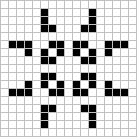بازی زندگی یا به طور مختصر زندگی (Life)، یک اتوماتای سلولی است که توسط ریاضیدان انگلیسی جان هورتون کانوی در سال ۱۹۷۰ میلادی به وجود آمد. بازی زندگی مشهورترین نمونه یک اتوماتای سلولی است.
زندگی یک بازی بدون بازیکن است، بدین معنا که تکامل آن تنها وابسته به وضعیت و شرایط آغازین آن بوده و نیازی به عامل ورودی انسانی در مراحل بعد ندارد. نحوه تراکنش انسانی با بازی بدین صورت است که فرد در شروع بازی حالت ابتدایی چیدمان را بوجود میآورد و سپس چگونگی رشد و تکامل سیستم را بدون دخالت خود مشاهده میکند.
قوانین
دنیای بازی زندگی از یک جدول نامتناهی دو بعدی با بردارهای متعامد ساخته شدهاست که شامل سلولهای مربع شکل است. هر سلول میتواند یکی از دو حالت زنده و یا مردهرا داشته باشد. هر سلول با هشت سلول همسایه و همجوار خود به صورت افقی، عمودی و مورب، در تراکنش است. در هر مرحله زمانی از بازی، تحولات زیر اتفاق میافتند:
- ۱. هر سلول زنده با کمتر از ۲ همسایه زنده، میمیرد. (به دلیل کمبود جمعیت)
- ۲. هر سلول زنده با بیش از ۳ همسایه زنده، میمیرد. (به دلیل ازدحام جمعیت)
- ۳. هر سلول زنده با ۲ و یا ۳ همسایه زنده، زنده میماند و به نسل بعد میرود.
- ۴. هر سلول مرده با دقیقا ۳ همسایه زنده، دوباره زنده میشود.
الگوی آغازین بازی به عنوان بذر سیستم به حساب میآید. اولین نسل در بازی با اعمال قوانین فوق بر تک تک سلولها به صورت همزمان ایجاد میشود و در آن زاد و ولدها و مرگ و میرها اتفاق میافتد. این رویه تا ایجاد نسلهای آینده ادامه مییابد. بدین ترتیب هر نسل تابعی از نسل ما قبل خود خواهد بود
Examples of patterns
The earliest interesting patterns in the Game of Life were discovered without the use of computers. The simplest static patterns ("still lifes") and repeating patterns ("oscillators"—a superset of still lifes) were discovered while tracking the fates of various small starting configurations using graph paper, blackboards, physical game boards (such as Go) and the like. During this early research, Conway discovered that the F-pentomino(which he called the "R-pentomino") failed to stabilize in a small number of generations. In fact, it takes 1103 generations to stabilize, by which time it has a population of 116 and has fired six escaping gliders[10] (in fact, these were the first gliders ever discovered).[11]
Many different types of patterns occur in the Game of Life, including still lifes, oscillators, and patterns that translate themselves across the board ("spaceships"). Some frequently occurring[12] examples of these three classes are shown below, with live cells shown in black, and dead cells shown in white.The "pulsar"[13] is the most common period 3 oscillator. The great majority of naturally occurring oscillators are period 2, like the blinker and the toad, but periods 4, 8, 14, 15, 30 and a few others have been seen on rare occasions.[14] Patterns called "Methuselahs" can evolve for long periods before stabilizing, the first-discovered of which was the F-pentomino. "Diehard" is a pattern that eventually disappears (rather than merely stabilize) after 130 generations, which is conjectured to be maximal for patterns with seven or fewer cells.[15] "Acorn" takes 5206 generations to generate 633 cells including 13 escaped gliders.[16]
| Oscillators | |
|---|---|
| Blinker (period 2) |  |
| Toad (period 2) |  |
| Beacon (period 2) | |
| Pulsar (period 3) |  |
| Spaceships | |
|---|---|
| Glider |  |
| Lightweight spaceship (LWSS) |  |
| Still lifes | |
|---|---|
| Block |  |
| Beehive |  |
| Loaf |  |
| Boat |  |

منبع: ویکی پدیا

